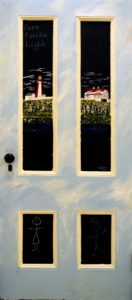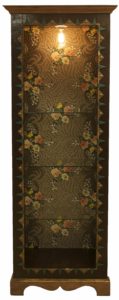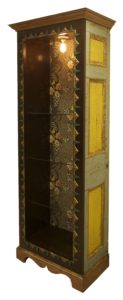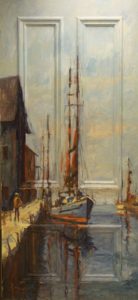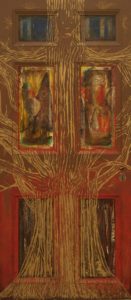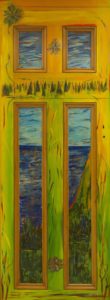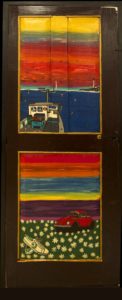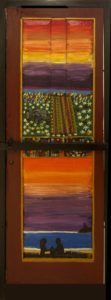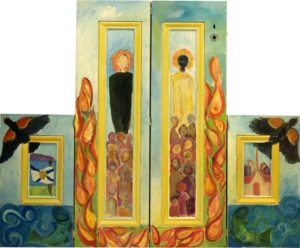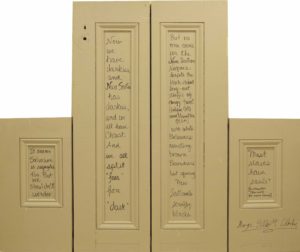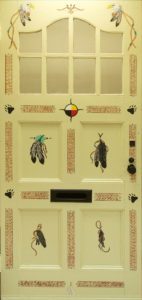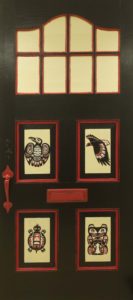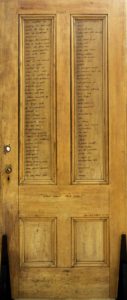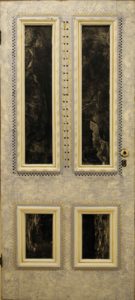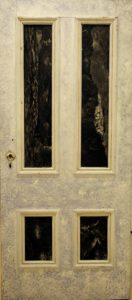These are the amazing DOORS that were auctioned in May 2016 as part of the GALA fund raising event in Yarmouth. They are shown here as part of the visual record.
Wayne Boucher
These are the two sides of Wayne Boucher’s doors. Notice the reference to our Nova Scotian origins. This door was originally a kitchen door at 27 Willow Street in Yarmouth and dates from 1887. It is 30 x 81 inches.
Channing Burchell
Life is a canvas and each of us has a unique story to paint. I try to fill mine with as much colour as I possibly can because the world already has enough darkness in it. I want to be the light. This door was originally at 27 Willow Street in Yarmouth in an upper bedroom. It dates from 1871. It is 31 x 81.5 inches.
Anne Marie Clow
Ann Marie Clow’s door plays with the theme of a useful note keeping surface with chalk and eraser provided. It is connected to Yarmouth through its images. The door was originally in Halifax a dates from 1910. It is 31 x 72.5 inches
Colette Deveau
Colette has created a ‘living’ door. Each of the small panels is removable and can be replaced by new self created art over time. Thus, the door is continually evolving with the family who owns it. Is an 1872 door from 25 Willam Street in Yarmouth. It is 30 x 81.5 inches.
Colette has this to say about her creation: “Our community, our country, the world is made up of many races, languages, cultures, women and men. We are all different, but we are all people. We are all one ‘people’. Seek peace, harmony, equality – yes. But don’t live in the shadow of others – of the masses – oppressed, silent. Be you. Be true to your spirit. Live. Love. Open the door. Unlock your fears. Release the spirit. Embrace your dreams. Love. Live!”
Flora Doehler
 Flora’s door is a wild exuberance of colour recalling a summer flowers. It dates from 1910 in Halifax and is 32 by 79.5 inches.
Flora’s door is a wild exuberance of colour recalling a summer flowers. It dates from 1910 in Halifax and is 32 by 79.5 inches.
Flora says: “Each year’s crop of flowers means a fresh, beautiful beginning. That determined persistence is embodied in a living, complex form that continues to inspire me.
Craig Dorsey
Craig has reconstructed his door as a fine arts cabinet using other found materials to complement the its character. The door is from the 1840’s, Beacon Hill, Boston. The construction is 31 inches wide, 80.5 inches high and 17.25 inches deep at the crown.
Michel Doucet
Michel’s door captures the spirit of the Nova Scotian days of sail and the vitality of the fishermen who were aboard. It dates fro 1887 as a door at 27 Willow Street in Yarmouth. It is 36 x 79.5 inches.
Richard Doucette
Richard has produced an exciting and dynamic door through use of colour and imaginative carving. The reverse of the door is “as found” with some enhancing use of additional colour. The door is from 1840’s, Beacon Hill, Boston. It is 31.25 x 75 inches.
Tootsie Emin
Ken Flett
 Ken says: I found the format of the door a challenge. In the beginning the only specific thing l had in mind were two wooden ships in battle and from there l tend to work intuitively. The theme of love and sadness are recurring in my work and l think it happens here. The door is from 1910 in Halifax and is 32 x 80 inches.
Ken says: I found the format of the door a challenge. In the beginning the only specific thing l had in mind were two wooden ships in battle and from there l tend to work intuitively. The theme of love and sadness are recurring in my work and l think it happens here. The door is from 1910 in Halifax and is 32 x 80 inches.
Lisa Francis
Lisa’s door is an expression of First Nation’s symbology and connection to the land of Nova Scotia. It is 32 x 73 inches.
Marilyn Francis
This door is dedicated to reflecting on the plight of First Nations women who have suffered abuse, become lost or killed. The figures on the door were created at each the First Nation reserves in Nova Scotia. The door is 32 x 82 inches.
Dave Gorman with Alex Gigeroff
Dave Gorman, one of Yarmouth’s up-and-c0ming young artists know for his bold compositions and exuberant colour use, teamed up with seasoned artist, Alex Gigeroff to create what has turned out to be the last art work in which Alex had a hand. Door is 30 x 79 inches. It is 1893, 17 Collins Street. Kitchen pantry door.
David gives us this insight to the door: “We collaborated fully on the door. Alex came up with the concept for the door: to have an “inside” and an “outside”. Alex would do sketches and give me his ideas and thoughts on it, and I translated these to the door.
Hermit of Jedore
This door has been reset into a custom frame and stand. It is a fine piece of interpretive folk art in the Nova Scotia tradition. The overall size with frame is 29.25 x 75 inches plus six inches on each side for support.
Anne LeBlanc
Anne’s door captures the freedom of the sustaining Nova Scotia landscape with its images of water, waterfalls and the bald eagle found her in abundance. The door dates from 1872 from 25 William Street in Yarmouth. It was a closet door in a bathroom. The door is 25 x 74 inches.
Anne has this to say about her door: “One side of my door has a river with rocks blocking it’s path, symbolizing the obstacles we all have in life, but the water finds a way around them, as we find ways around our obstacles. The mighty eagle soars overhead reminding us there is always someone or something looking out for us.
The other side of the door shows the river transformed into a waterfall with all it’s splendor. The eagle is still keeping guard.”
Roy Mandell
Roy’s door is a true inspiration, an evolving creative subject approach to those familiar with his work. References from art history are rampant. Interpretations are brilliant. The door is 35.5 by 79 inches.
Roy had this to say about his creation.
I pried the mouldings off of the panels and glued 1/2 inch boards into the spaces to make the entire door a flush surface. I had no idea what to do so I started with a baby in utero and built outward from there watching the concept unfold not knowing where it would go until it gradually appeared on the door. The opposite of conceptual art where the idea is first. As a painter I just wanted to know how to make a painting that looked like old paintings I love in museums and books and the internet.
Lara Martina
Lara Martina’s door is reflective of a portable alter backdrop and has a social justice theme. She has incorporated a signed poem by George Eliot Clarke in this collaborative effort. The door dates to 1872 and is from the kitchen at 27 Willow Street in Yarmouth. It is 60 inches wide by 50.75 inches high but it is hinged and folds in four pieces.
She has this to say about the work as it is based on observations of history that are important to its creation.
TEXT: A Letter From Henry Tucker, August 28th, 1789 Verse V
Now we have darkies,
and Nova Scotia has darkies,
and we all have Christ.
And we all split “fair” from “dark.”
But no one cares for the Nova Scotian Negroes, despite the black- robed, long-coat traffic
of clergy twixt Halifax (NS) and Hamilton (BDA), with white Believers assisting brown Bermudians, but ignoring New Scotland’s scruffy blacks.
“NS has had historic encounters with racism, segregated areas, discrimination, hatred, forced relocation, and a loss of a sense of identity and a sense of belonging experienced by Black descendants though they had settled in Canada for hundreds of years.” Ruth Holmes Whitehead
By camouflaging/not camouflaging the door in the creation of an altarpiece I am making reference to how we as humans choose, or do not choose, to camouflage our identity, our race.It is an engagement with the question of the possibility of language and how the human relation to Being is sketched out through text and art.My art and the poetry of George Elliott Clarke are shaped by the landscape through which we move – thus the inclusion of NS landscape icons – The Baptist Churches, Blomidon etc.
As Emerson says : “ The ground is memoranda and signature.”
Olivia Sawler
Olivia Sawler is an art student at Yarmouth High School. Her door is a an expression of her reflections on her life with images of childhood transforming into where she is today looking to the future. The door is from 1872 as a bedroom door at 25 Willow Street in Yarmouth. It is 30 x 81.75 inches.
Kathy Seaboyer
 Kathy’s door is one of a few that uses a three dimensional approach of carving and adding to the original door planes. It is a very thoughtful door on state of humanity and will be the subject of much thinking and interpretation. The door is 32 x 79.25 inches.
Kathy’s door is one of a few that uses a three dimensional approach of carving and adding to the original door planes. It is a very thoughtful door on state of humanity and will be the subject of much thinking and interpretation. The door is 32 x 79.25 inches.
Maggie Schmidt
Maggie’s door is a joyful expression of warm images with a Victorian flare on one side and a beautiful combination of satiny golds and silvers on the other. It is one of the smaller doors, just 26.5 x 66.25 inches. It is from 25 Willow Street in Yarmouth.
Maggie has this to say about her door.
My door came from the bathroom of a Victorian Era house. This triggered my imagination. First that decoratively it was in the Art Nouveau period which I happen to love and I Decided to explore. The one side of the door, silver, gold and copper leafed with art nouveau designs states the period in which the door lived. The fact that is was a bathroom door, suggested to me what perhaps could happen behind closed doors. I explored the Czech artist Muncha who painted lovely sensual ladies. I googled Victorian Nudes and found a plethora of wonderful naked ladies…and decided they should be my models. With a bordello point of view I painted these ladies surrounded by Irises, also in my mind a very erotic plant. I then stencilled in copper oil paint a floral pattern to fill in the blanks. The Victorians were always over the top with decoration. I call the door UNHINGED.
About myself, I have always made my living as an artist. One way was as a decorative artist and interior designer embellishing people homes.
Mary Pitman
Mary Pitman did this symbolic door expressing the unity of First Nations peoples from East to West coast. This door is 36 by 79.5 inches.
Brian Porter
Brian’s door is an exemplary example of his imaginative and sometimes dream-like approach to painting. His strong graphic approach is evident. This door dates from 1887 when it was a kitchen door at 27 Willow Street in Yarmouth. The door is 30 x 83.25 inches.
Steven Rhude
Steven Rhude’s door incorporates a whimsical theme of coastal Nova Scotia and a personal observation poem. It is 36 x 84 inches.
Diane Rosati
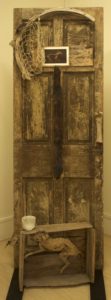 Diane’s first door is entitled “The Old Homestead”. It is a construction of found objects from in and around her 1787 farmhouse and reflect a feeling of days gone by. The door includes a mezzotint of her long dead whippet called Trouble and represents the hunt for the cat. It has been shown at various shows starting in New York city, going to Home Museum, and winning first prize at the found objects show at the Osprey Theater and Gallery in Shelburne, NS. It is a narrow 23.5 x 73.5 inches. The box with cat at the bottom is a separate piece.
Diane’s first door is entitled “The Old Homestead”. It is a construction of found objects from in and around her 1787 farmhouse and reflect a feeling of days gone by. The door includes a mezzotint of her long dead whippet called Trouble and represents the hunt for the cat. It has been shown at various shows starting in New York city, going to Home Museum, and winning first prize at the found objects show at the Osprey Theater and Gallery in Shelburne, NS. It is a narrow 23.5 x 73.5 inches. The box with cat at the bottom is a separate piece.
The second door has various “state” etchings inserted into the panels and reflects Diane’s background as a printmaker. It uses prints as collage. This door has been stippled using bait bags. Stencilling and old hardware have been incorporated. It is all about the visual in art. This door is 31.75 x 72.5 inches.





